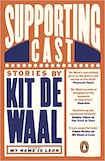
In an interview in these pages in 2016, Kit de Waal was asked if she “saw” her characters in her mind’s eye. “Oh, God. Totally,” she replied. “Every character in Leon has got a back story that I’ve written on my computer.” She wasn’t exaggerating. Her latest book, Supporting Cast, is a collection of stories, or more accurately character sketches, of peripheral characters from her first two novels, My Name Is Leon and The Trick to Time.
Of the 22 characters depicted here, some are easily recognisable, others less so. We meet Leon’s absent mother, Carol Rycroft, and later his father, Byron Francis. We also get an insight into what became of his brother, Jake. From The Trick to Time, three MacNaughtons – William, Cornelia and Margaret – each make an appearance, as does Karl, Mona’s German neighbour, and her friend, Gayle. Others are harder to pin down, such as Edith Paisley-Jones, a woman who appears for but a moment in My Name Is Leon but whose inner psyche is fleshed out in Supporting Cast.
In a way, this book’s very existence feels like an apology to those characters who, on first telling, seemed to matter less. Everyone’s story matters, this book suggests – a theme that resonates loudly in the world of fiction, and perhaps the world at large.
It's a strange exercise, trying to make a book stand both alone and in tandem with another
There doesn’t seem to be a particular logic to how these tales are laid out. We jump around from Bristol 1981 to Cambridge 2011 to Hamburg 2016. This gives things a scattered feel – it’s not always easy to find your bearings, and some stories are so short or subtle they seem to brush past you on first read.
Readers already familiar with de Waal’s work will certainly get more out of this book. Mr Devlin, for example, is portrayed as a man carrying around some form of depression: “He called it ‘the filth’ because it was impossible to wash away.” It’s poetic but obscure, but having met Mr Devlin in Leon, another dimension is added to his melancholy.
It’s a strange exercise, trying to make a book stand both alone and in tandem with another. One story in which this does work is Carol’s. We meet her in a B&B in Bristol. There is something bubbling in her unstable mind. “It was very strange what happened then,” we are told. “It was like a very bad person put their hand on Carol’s shoulder and whispered something so horrible and frightening that she wanted to die.” It’s a telling yet mysterious line, reminiscent of something Elizabeth Bowen might plant in a story. Readers of Leon might recognise why this “horrible” feeling haunts Carol, but even if not, we feel the quiet menace and are guided shrewdly towards the conclusion.
Happy-sadness
For the most part, this book’s power lies in how it conveys a happy-sadness. Each character-portrait is rendered like a da Vinci: sheer darkness playing off glowing light.
The story of Becky Finch organising a holiday with her workmates is sliced through with the memory of her mother – “we know you miss your mum, love, but it’s not like it’s a shock, was it?” We are told that her mother had been unstable for years, and that she once came at Becky “with a knife but she thought it was a hairbrush”. The story is slashed through the middle with sadness, then pulled back again, to talk of beach bags and sun cream and doing Becky’s hair, as if the pain wasn’t sharp – as if the knife really was a hairbrush.
The book will suit the patient, perceptive reader who is willing to go back again and again
I was most drawn to the story of Sylvia, who we meet after her marriage has broken down. She describes nights where her alcoholic husband would stay out until six in the morning: “First time it happens, you think the worst. He’s dead. Robbed. Stabbed.” There’s a bitterness tinged with nostalgia and love. “You loved him,” says her sister, “and he loved you. And even if it’s not like that now, you have to remember the sunshine.”
From there, the story becomes another story. Sylvia remembers a time she and her husband were on holidays and he tried to save a drowning boy. It is as if we are reading backwards. We are hopeful for a future we have already seen. The effect is quite stunning.
Ultimately, although this book doesn’t quite have the pulling power of de Waal’s novels, it will suit the patient, perceptive reader who is willing to go back again and again – to tease out its controlled, telling sentences. It should be obvious, I suppose, that there is more to these characters than can be seen at first glance.












